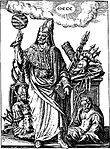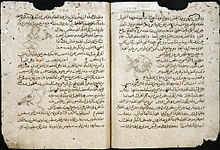Cyranides
| Part of a series on |
| Hermeticism |
|---|
 |
The Cyranides (also Kyranides or Kiranides) is a compilation of
In the
Form and structure

The original 4th-century Cyranides comprised three books, to which a redactor added a fourth. The original first book of the Cyranides, the Κυρανίς (Kuranis), was the second component of a two-part work, the first part of which was the Ἀρχαϊκἠ (Archaikê). Books 2–4 are a bestiary. The edition of Kaimakis (see below) contains a fifth and sixth book which were not transmitted under the name Cyranides but which were included with the work in a limited number of manuscripts. A medieval Arabic translation of the first book exists, and portions of it are "reflected" in the Old French work Le livre des secrez de nature (The Book of Nature's Secrets).
The Cyranides begins by instructing the reader to keep its contents secret, and with a fictional narrative of how the work was discovered.
Sample remedies and spells
The Cyranides devotes a chapter to the healing powers of the water snake; its
Daniel Ogden, a specialist in magic and the supernatural in antiquity, has gathered several references from the Cyranides on the use of gemstones and amulets.[15] The collection offers spells to avert the child-harming demon Gello, who was blamed for miscarriages and infant mortality, and says that aetite can be worn as an amulet against miscarriage.[16]
Magico-religious tradition
Olympidorus provides a summary of a passage from the work, not part of the abridged version now extant, that has cosmological as well as alchemical implications:

Again in Kyranis
cockerel, Hermes says, was once a man, cursed by the sun. This he says in the book called Ancient (archaike). In it he also makes mention of the mole, saying that it too was once a man. It was cursed by god for revealing the secrets of the sun. And the sun made it blind and if it happens to be observed by the sun, the earth does not receive it till evening. He says '<the sun made it blind> as it knew as well what was the shape of the sun.' He exiled it in the melanitis land [black earth?],[17] as a law-breaker and divulger of his secret to the human race.[18]
In the extant version, the Cyranides contains a description of the heliodromus, a phoenix-like bird from India which, upon hatching, flies to the rising sun and then goes west when the sun passes the zenith. It lives only a year, and, according to some interpretations of an unreliable text, leaves behind an androgynous progeny.[19]
Editions and translations
- Delatte, Louis (1942). Textes latins et vieux français relatifs aux Cyranides. Paris: Droz. OCLC 901714095. The Latin translation.
- Kaimakis, Dimitris (1976). Die Kyraniden. Meisenheim am Glan: Hain. ISBN 9783445013347. (NB: Kaimakis did not consult the Latin text while making this edition).
- Ruelle, M. Ch.-Ém. (1898). Les lapidaires de l'antiquité et du moyen-âge 2. Les lapidaires grecs, Tome 2, Fascicule 1. Paris.
{{cite book}}: CS1 maint: location missing publisher (link) Partial Greek text. - Toral-Niehoff, Isabel (2004). Kitab Giranis. Die arabische Übersetzung der ersten Kyranis des Hermes Trismegistos und die griechischen Parallelen. München: Herbert Utz. ISBN 3-8316-0413-4. Arabic translation and partial Greek text; Greek text contains many typographical errors.
- Ullmann, Manfred (2020). "Die arabischen Fragmente der Bücher II bis IV der Kyraniden". Studia graeco-arabica. 10: 49–58. (Arabic translation of fragments from books 2–4 of the Cyranides)
- Waegeman, Maryse (1987). Amulet and Alphabet: Magical Amulets in the First Book of Cyranides. Amsterdam: J. C. Gieben. OCLC 17009220. English translation and commentary on select passages from Book 1.
Selected bibliography
- Bain, David. "Μελανῖτις γῆ in the Cyranides and Related Texts: New Evidence for the Origins and Etymology of Alchemy." In Magic in the Biblical World: From the Rod of Aaron to the Ring of Solomon. T&T Clark International, 2003, pp. 191–218. Limited preview online.
- Bain, David. "περιγίνεσθαι as a Medical Term and a Conjecture in the Cyranides." In Ethics and Rhetoric: Classical Essays for Donald Russell on His Seventy-Fifth Birthday. Oxford: Clarendon Press, 1995, pp. 281–286. Limited preview online.
- Faraone, Christopher A. Ancient Greek Love Magic. Harvard University Press, 2001. Limited preview online.
- Mavroudi, Maria. "Occult Science and Society in Byzantium: Considerations for Future Research." University of California, Berkeley. Full text downloadable. Also published in The Occult Sciences in Byzantium (La Pomme d'or, 2006), limited preview online.
References
- ^ David Bain, "περιγίνεσθαι as a Medical Term and a Conjecture in the Cyranides," in Ethics and Rhetoric: Classical Essays for Donald Russell on His Seventy-Fifth Birthday (Oxford: Clarendon Press, 1995), p. 283 online. Christopher A. Faraone, Ancient Greek Love Magic p. 121, dates the work to the 1st century.
- ^ French, "living text"; that is, an "open" document or text undergoing continuing revision by multiple hands and existing in no one authoritative form; see Wikipedia.
- ^ Faraone, Ancient Greek Love Magic, pp. 11 and 121.
- Rod of Aaron to the Ring of Solomon(T&T Clark International, 2003), pp. 209–210, especially note 64.
- ^ Jeffrey B. Gibson, Temptations of Jesus in Early Christianity (Continuum International Publishing, 2004), p. 246 online; used as a source by James A. Kelhoffer, The Diet of John the Baptist: "Locusts and Wild Honey" in Synoptic and Patristic Interpretation (Mohr Siebeck, 2005), passim.
- ^ Maria Mavroudi, "Occult Science and Society in Byzantium: Considerations for Future Research," University of California, Berkeley, p. 84, full text downloadable.[dead link]
- ^ As cited by Bain, "Μελανῖτις γῆ," p. 208.
- ^ Bain, "Μελανῖτις γῆ," p. 208, note 61; Mavroudi, "Occult Science and Society in Byzantium," p. 84.
- ^ Bain, "Μελανῖτις γῆ," pp. 195 online, 203 and 209; "περιγίνεσθαι as a Medical Term," p. 283; "Some Textual and Lexical Notes on Cyranides 'Books Five and Six'," Classica et Mediaevalia 47 (1996), pp. 151–168 online.
- ^ Mavroudi, "Occult Science and Society in Byzantium," p. 74.
- ^ Bain, "περιγίνεσθαι as a Medical Term," p. 283.
- ^ Erich S. Gruen, Diaspora: Jews Amidst Greeks and Romans (Harvard University Press, 2004), p. 319 online.
- ^ Faraone, Ancient Greek Love Magic, p. 21, note 93. The possession of a molar by a skink seems not to be questioned; one wonders whether the translation is accurate.
- ^ Mavroudi, "Occult Science and Society in Byzantium," p. 84, note 137.
- ^ Daniel Ogden, Magic, Witchcraft, and Ghosts in the Greek and Roman Worlds: A Sourcebook (Oxford University Press, 2002), passim, limited preview online.
- ^ Sarah Iles Johnston, Restless Dead: Encounters Between the Living and the Dead in Ancient Greece (University of California Press, 1999), pp. 166–167 online.
- is now the standard view.
- ^ Bain, "Μελανῖτις γῆ," p. 199
- ISBN 978-2-7535-2735-5)
